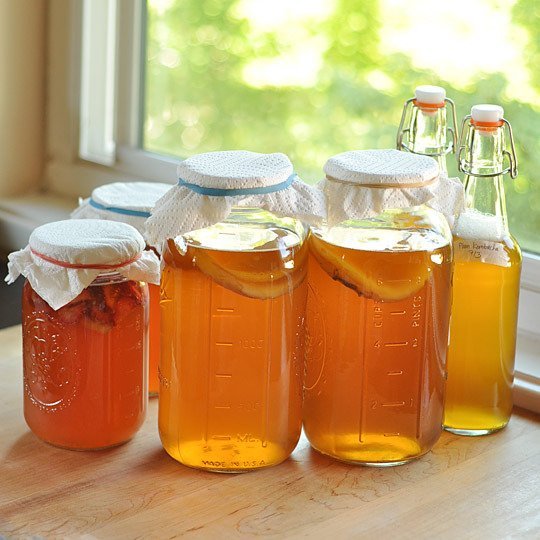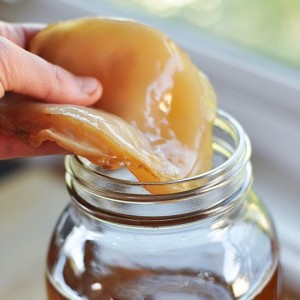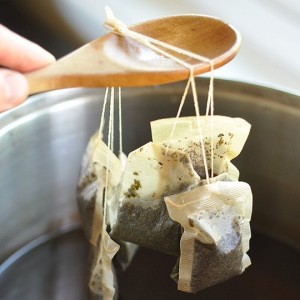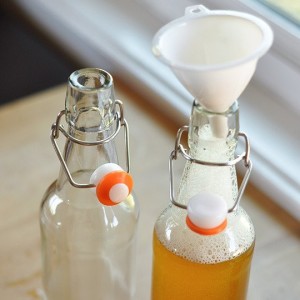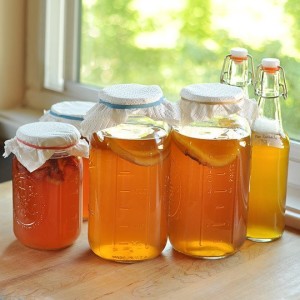What Is Kombucha Tea?
The first recorded use of Kombucha was in 221 B.C. during the Chinese empire of the Tsin-Dynasty. They called it “The remedy for immortality” or the “divine tische”. It is a living health drink which has been used for thousands of years to help stimulate the metabolism and maintain a healthy immune system.
Kombucha starts out as a sugary tea, which is then fermented with the help of a scoby. “SCOBY” is actually an acronym for “symbiotic culture of bacteria and yeast.”
The scoby bacteria and yeast eat the majority of the sugar in the tea, transforming the tea into a refreshingly fizzy, slightly sour fermented (but mostly non-alcoholic) beverage that is relatively low in calories. Flavours can be added to the Kombucha such as ginger, pear or blackberries.
The SCOBY
Let’s talk about that scoby. It’s weird, right?! It floats, it’s rubbery and slightly spongy, brown stringy bits hang from it, and it transforms sugary tea into something fizzy and sour. It’s totally weird. But if you take a step back, it’s also pretty awesome.
There are a lot of theories about why the bacteria and yeast form this jelly-like layer of cellulose at the top of the kombucha. The most plausible that I’ve found is that it protects the fermenting tea from the air and helps maintain a very specific environment inside the jar that is shielded from outsiders, aka unfriendly bacteria.
Probiotics?
Which brings us to the next question: what’s actually in kombucha? Kombucha is indisputably full of probiotics and other happy things that our intestines love and that help boost our overall health.

How to Make Kombucha Tea at Home
What You Need
Ingredients
4.5 cups of filtered water
1 cup white sugar or raw brown sugar – The less processing the better
8 bags black tea (or 2 tablespoons loose tea) – I prefer English Breakfast tea
2 cups starter tea from last batch of kombucha or store-bought (unpasteurized, neutral-flavoured) kombucha
1 scoby per fermentation jar
Optional flavouring extras for bottling: 1 to 2 cups chopped fruit, ginger, turmeric, lime, 2 to 3 cups fruit juice, 1 to 2 tablespoons flavoured tea (like hibiscus or Earl Grey), 1/4 cup honey, 2 to 4 tablespoons fresh herbs or spices
Equipment
Stock pot
A jar big enough to hold 4 cups of water with room spare
Bottles: Six 16-oz glass bottles with plastic lids, 6 swing-top bottles, or clean soda bottles
Small funnel
Instructions
Note: Avoid prolonged contact between the kombucha and metal both during and after brewing. This can affect the flavour of your kombucha and weaken the scoby over time.
1. Make the Tea Base: Bring the water to a boil. Remove from heat and stir in the sugar to dissolve. Drop in the tea and allow it to steep until the water has cooled. Depending on the size of your pot, this will take a few hours. You can speed up the cooling process by placing the pot in an ice bath.
2. Add the Starter Tea: Once the tea is cool, remove the tea bags or strain out the loose tea. Stir in the starter tea. (The starter tea makes the liquid acidic, which prevents unfriendly bacteria from taking up residence in the first few days of fermentation.)
3. Transfer to Jars and Add the Scoby: Pour the mixture into your glass jar and gently slide the scoby or fermented little bits that will be floating in the bottom of a store bought kombucha, into the jar with clean hands. Cover the mouth of the jar with a few layers of cheesecloth or paper towels secured with a rubber band.
4. Ferment for 7 to 10 Days: Keep the jar at room temperature, out of direct sunlight, and where it won’t get touched or moved around. Ferment for 7 to 10 days, checking the kombucha and the scoby periodically.
It’s not unusual for the scoby to float at the top, bottom, or even sideways. A new cream-colored layer of scoby should start forming on the surface of the kombucha within a few days. It usually attaches to the old scoby, but it’s ok if they separate. You may also see brown stringy bits floating beneath the scoby, sediment collecting at the bottom, and bubbles collecting around the scoby. This is all normal and signs of healthy fermentation.
After seven days, begin tasting the kombucha daily by pouring a little out of the jar and into a cup. When it reaches a balance of sweetness and tartness that is pleasant to you, the kombucha is ready to bottle.
5. Remove the Scoby: Before proceeding, prepare and cool another pot of strong tea for your next batch of kombucha, as outlined above. With clean hands, gently lift the scoby out of the kombucha and set it on a clean plate. As you do, check it over and remove the bottom layer if the scoby is getting very thick.
6. Bottle the Finished Kombucha: Measure out your starter tea from this batch of kombucha and set it aside for the next batch. Pour the fermented kombucha (straining, if desired) into bottles using the small funnel, along with any juice, herbs, or fruit you may want to use as flavouring. Leave about a half inch of head room in each bottle. (Alternatively, infuse the kombucha with flavourings for a day or two in another jar covered with cheesecloth, strain, and then bottle. This makes a cleaner kombucha without “stuff” in it.)
7. Carbonate and Refrigerate the Finished Kombucha: Store the bottled kombucha at room-temperature out of direct sunlight and allow 1 to 3 days for the kombucha to carbonate (the added fruit you added allows for a second fermentation process which is where it becomes carbonated). Until you get a feel for how quickly your kombucha carbonates, it’s helpful to keep it in plastic bottles; the kombucha is carbonated when the bottles feel rock solid. Refrigerate to stop fermentation and carbonation, and then consume your kombucha within a month. It is a good idea to open the bottle to let some gas/air bubbles out otherwise it will explode like a Champaign bottle!
8. Make a Fresh Batch of Kombucha: Clean the jar being used for kombucha fermentation. Combine the starter tea from your last batch of kombucha with the fresh batch of sugary tea, and pour it into the fermentation jar. Slide the scoby on top, cover, and ferment for 7 to 10 days.
Additional Notes:
• Batch Size: To increase or decrease the amount of kombucha you make, maintain the basic ratio of 1 cup of sugar, 8 bags of tea, and 2 cups starter tea per 4 cups water batch. One scoby will ferment any size batch, though larger batches may take longer.
• Putting Kombucha on Pause: If you’ll be away for 3 weeks or less, just make a fresh batch and leave it on your counter. It will likely be too vinegary to drink by the time you get back, but the scoby will be fine. For longer breaks, store the scoby in a fresh batch of the tea base with starter tea in the fridge. Change out the tea for a fresh batch every 4 to 6 weeks.
• Other Tea Options: Black tea tends to be the easiest and most reliable for the scoby to ferment into kombucha, but once your scoby is going strong, you can try branching out into other kinds. Green tea, white tea, oolong tea, or a even mix of these make especially good kombucha. Herbal teas are ok, but be sure to use at least a few bags of black tea in the mix to make sure the scoby is getting all the nutrients it needs. Avoid any teas that contain oils, like earl grey or flavored teas.
• Avoid Prolonged Contact with Metal: Using metal utensils is generally fine, but avoid fermenting or bottling the kombucha in anything that brings them into contact with metal. Metals, especially reactive metals like aluminum, can give the kombucha a metallic flavor and weaken the scoby over time.
Troubleshooting Kombucha
• It is normal for the scoby to float on the top, bottom, or sideways in the jar. It is also normal for brown strings to form below the scoby or to collect on the bottom. If your scoby develops a hole, bumps, dried patches, darker brown patches, or clear jelly-like patches, it is still fine to use. Usually these are all indicative of changes in the environment of your kitchen and not a problem with the scoby itself.
• Kombucha will start off with a neutral aroma and then smell progressively more vinegary as brewing progresses. If it starts to smell cheesy, rotten, or otherwise unpleasant, this is a sign that something has gone wrong. If you see no signs of mold on the scoby, discard the liquid and begin again with fresh tea. If you do see signs of mold, discard both the scoby and the liquid and begin again with new ingredients.
• A scoby will last a very long time, but it’s not indestructible. If the scoby becomes black, that is a sign that it has passed its lifespan. If it develops green or black mold, it is has become infected. In both of these cases, throw away the scoby and begin again.
• To prolong the life and maintain the health of your scoby, stick to the ratio of sugar, tea, starter tea, and water outlined in the recipe. You should also peel off the bottom (oldest) layer every few batches. This can be discarded, composted, used to start a new batch of kombucha, or given to a friend to start their own.
• If you’re ever in doubt about whether there is a problem with your scoby, just continue brewing batches but discard the kombucha they make. If there’s a problem, it will get worse over time and become very apparent. If it’s just a natural aspect of the scoby, then it will stay consistent from batch to batch and the kombucha is fine for drinking.
Brewing Kombucha Safely
And while the homebrewed nature of kombucha makes some home cooks nervous, is unlikely that kombucha will ever make you sick. Like all things, you need to use common sense when brewing it and pay attention to what you’re doing. It’s natural to feel nervous and unsure at first. Bottom line: if the scoby is healthy, then the kombucha will be healthy.
Is There Alcohol in Kombucha?
Kombucha does contain a little bit of alcohol as a by-product of the fermentation process. It is usually no more than 1%. Unless you drink a lot of it back to back, you won’t get drunk. But people with alcohol sensitivities should be aware of its presence.
I’m breaking the kombucha-making process into very small steps here. It looks long and complicated, but this is actually a very straightforward and streamlined process. Once you get into the rhythm of it, bottling a finished batch of kombucha and preparing the next only takes about 20 minutes every 7 to 10 days.
Where to Find Kombucha Brewing Supplies
You can use regular, store-bought tea and sugar for brewing kombucha. You can pick up a scoby from a kombucha-brewing friend or even make your own. They are available online also, however give starting your own from scratch a go!
Have fun ! Take care of you, see you in the clinic,
TK xx
Learn more > http://www.tanyakeamwellness.com

